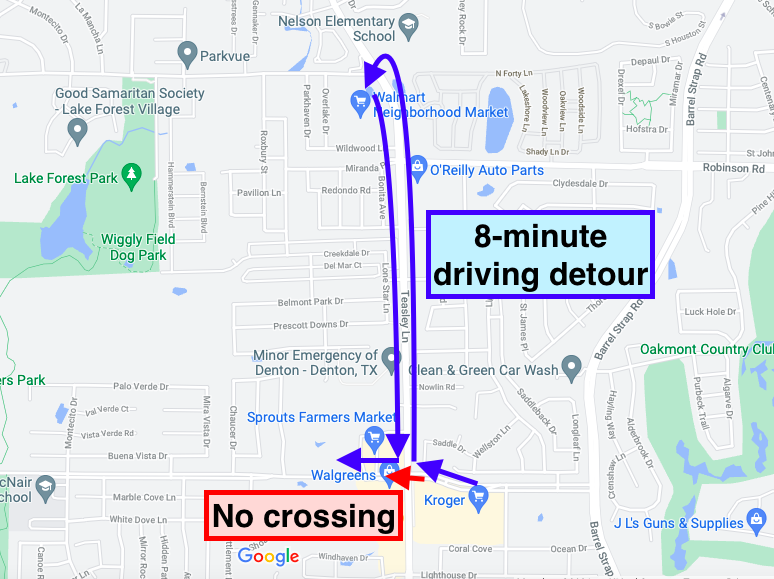Pedestrian Access to be Limited along Hickory Creek Road
November 22, 2021
Hickory Creek Road in south Denton is undergoing more than $220 million in road expansion projects to move motor vehicles more quickly in a growing area of town. To allow for faster vehicular movement, pedestrian and bicycle crossing opportunities will be limited along the corridor.
According to information from a recent city Mobility Committee meeting, there will be no direct connection across Hickory Creek Road for trail users traveling between Cross Timbers Park and Cross Timbers Park South. These trails also connect to McNair Elementary School.
White arrow showing direct connection between trails. A trail crossing is not planned across Hickory Creek Road.
Trail users wishing to connect from one trail to the other will be required to make an eight-minute detour to Montecito Drive and back in order to cross the road. A traffic light is planned at Montecito, which would make crossing safer but also increase total detour time.
For a driving equivalent of this detour, imagine traveling along Hickory Creek Road and needing to cross Teasley to travel from Kroger to Walgreens. Imagine being banned from crossing Teasley directly and instead being forced to drive to Ryan Road and back just to get to the other side of Teasley. Imagine having to take this detour every time you want to drive across Teasley. Would this detour be acceptable?
What if you weren’t allowed to drive across Teasley Lane at Hickory Creek Road and instead had to drive up to Ryan Road and back every time?
Example of an eight-minute driving detour: Hickory Creek to Ryan Road and back.
These are the detours we expect people outside of a car to tolerate on a regular basis.
Most humans are not willing to tolerate these detours and will take risks to cross dangerous roads wherever is most convenient. If drivers on Hickory Creek Road were legally required to drive to Ryan Road and back every time they wanted to cross Teasley, many would likely ignore the law and drive straight through the intersection when possible. People traveling outside of a car are the same--they will cross illegally rather than waste time on detours.
Fast roads like Hickory Creek are considered necessary when the development pattern is sprawl. In a compact development pattern, someone can walk, bike, or roll to most daily destinations within 15 minutes of travel time. When residences and destinations are spread farther apart, an automobile is needed to access needs within 15 minutes. As more people drive, and development is spread further apart, the desire grows for expensive, wide, high-speed roads like Hickory Creek Road.
Despite its planned sidewalks and multi-use paths, Hickory Creek is the type of road that creates car dependency. Its width and lethal speeds make it dangerous and unpleasant for people outside of a car, so most people will choose to drive in order to feel safer.
The primary purpose of Hickory Creek Road is to move automobiles quickly. All other road users are secondary. As a result, it is designed with fewer crossings and intersections, which reduces the need for Hickory Creek vehicular traffic to slow or stop and minimizes the number of conflict points where a crash could occur.
Limited crossings on Hickory Creek Road is a good thing if our primary goal is to move automobiles quickly. However, it’s a bad thing if our primary goal is to provide safe, convenient, healthy, and affordable transportation options like biking, walking, and using other small personal mobility devices.
Cross Timbers Trail







